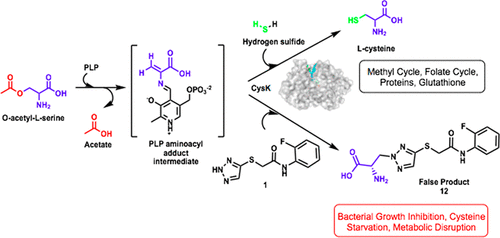当前位置:
X-MOL 学术
›
ACS Infect. Dis.
›
论文详情
Our official English website, www.x-mol.net, welcomes your feedback! (Note: you will need to create a separate account there.)
Discovery and Characterization of the Antimetabolite Action of Thioacetamide-Linked 1,2,3-Triazoles as Disruptors of Cysteine Biosynthesis in Gram-Negative Bacteria.
ACS Infectious Diseases ( IF 5.3 ) Pub Date : 2020-01-13 , DOI: 10.1021/acsinfecdis.9b00406 Miranda J Wallace 1, 2 , Suresh Dharuman 1 , Dinesh M Fernando 1 , Stephanie M Reeve 1 , Clifford T Gee 1 , Jiangwei Yao 3 , Elizabeth C Griffith 1 , Gregory A Phelps 1 , William C Wright 1 , John M Elmore 1 , Robin B Lee 1 , Taosheng Chen 1 , Richard E Lee 1
ACS Infectious Diseases ( IF 5.3 ) Pub Date : 2020-01-13 , DOI: 10.1021/acsinfecdis.9b00406 Miranda J Wallace 1, 2 , Suresh Dharuman 1 , Dinesh M Fernando 1 , Stephanie M Reeve 1 , Clifford T Gee 1 , Jiangwei Yao 3 , Elizabeth C Griffith 1 , Gregory A Phelps 1 , William C Wright 1 , John M Elmore 1 , Robin B Lee 1 , Taosheng Chen 1 , Richard E Lee 1
Affiliation

|
Increasing rates of drug-resistant Gram-negative (GN) infections, combined with a lack of new GN-effective antibiotic classes, are driving the need for the discovery of new agents. Bacterial metabolism represents an underutilized mechanism of action in current antimicrobial therapies. Therefore, we sought to identify novel antimetabolites that disrupt key metabolic pathways and explore the specific impacts of these agents on bacterial metabolism. This study describes the successful application of this approach to discover a new series of chemical probes, N-(phenyl)thioacetamide-linked 1,2,3-triazoles (TAT), that target cysteine synthase A (CysK), an enzyme unique to bacteria that is positioned at a key juncture between several fundamental pathways. The TAT class was identified using a high-throughput screen against Escherichia coli designed to identify modulators of pathways related to folate biosynthesis. TAT analog synthesis demonstrated a clear structure-activity relationship, and activity was confirmed against GN antifolate-resistant clinical isolates. Spontaneous TAT resistance mutations were tracked to CysK, and mode of action studies led to the identification of a false product formation mechanism between the CysK substrate O-acetyl-l-serine and the TATs. Global transcriptional responses to TAT treatment revealed that these antimetabolites impose substantial disruption of key metabolic networks beyond cysteine biosynthesis. This study highlights the potential of antimetabolite drug discovery as a promising approach to the discovery of novel GN antibiotics and the pharmacological promise of TAT CysK probes.
中文翻译:

硫代乙酰胺连接的1,2,3-三唑类化合物作为革兰氏阴性细菌中半胱氨酸生物合成的干扰物的抗代谢作用的发现和表征。
耐药革兰氏阴性(GN)感染率的上升,再加上缺乏新的GN有效抗生素种类,驱使人们需要发现新的药物。细菌代谢代表了当前抗菌疗法中未充分利用的作用机制。因此,我们寻求鉴定破坏关键代谢途径的新型抗代谢物,并探索这些药物对细菌代谢的特定影响。这项研究描述了这种方法的成功应用,以发现一系列针对N-(苯基)硫代乙酰胺连接的1,2,3-三唑(TAT)的新化学探针,该探针针对半胱氨酸合酶A(CysK),细菌位于几个基本途径之间的关键关头。使用针对大肠杆菌的高通量筛选来鉴定TAT类,该筛选旨在鉴定与叶酸生物合成相关的途径的调节剂。TAT类似物的合成证明了明确的结构-活性关系,并确认了对GN抗叶酸耐药临床分离株的活性。自发的TAT抗性突变被追踪到CysK,并且作用方式研究导致在CysK底物O-乙酰基-1-丝氨酸和TAT之间鉴定出错误的产物形成机制。TAT治疗的全球转录反应表明,这些抗代谢物对半胱氨酸生物合成以外的关键代谢网络造成了重大破坏。
更新日期:2020-01-14
中文翻译:

硫代乙酰胺连接的1,2,3-三唑类化合物作为革兰氏阴性细菌中半胱氨酸生物合成的干扰物的抗代谢作用的发现和表征。
耐药革兰氏阴性(GN)感染率的上升,再加上缺乏新的GN有效抗生素种类,驱使人们需要发现新的药物。细菌代谢代表了当前抗菌疗法中未充分利用的作用机制。因此,我们寻求鉴定破坏关键代谢途径的新型抗代谢物,并探索这些药物对细菌代谢的特定影响。这项研究描述了这种方法的成功应用,以发现一系列针对N-(苯基)硫代乙酰胺连接的1,2,3-三唑(TAT)的新化学探针,该探针针对半胱氨酸合酶A(CysK),细菌位于几个基本途径之间的关键关头。使用针对大肠杆菌的高通量筛选来鉴定TAT类,该筛选旨在鉴定与叶酸生物合成相关的途径的调节剂。TAT类似物的合成证明了明确的结构-活性关系,并确认了对GN抗叶酸耐药临床分离株的活性。自发的TAT抗性突变被追踪到CysK,并且作用方式研究导致在CysK底物O-乙酰基-1-丝氨酸和TAT之间鉴定出错误的产物形成机制。TAT治疗的全球转录反应表明,这些抗代谢物对半胱氨酸生物合成以外的关键代谢网络造成了重大破坏。



























 京公网安备 11010802027423号
京公网安备 11010802027423号